The global probiotic desserts market was valued at $680.7 million in 2021, and is projected to reach $1.4 billion by 2031, growing at a CAGR of 7.2% from 2022 to 2031.
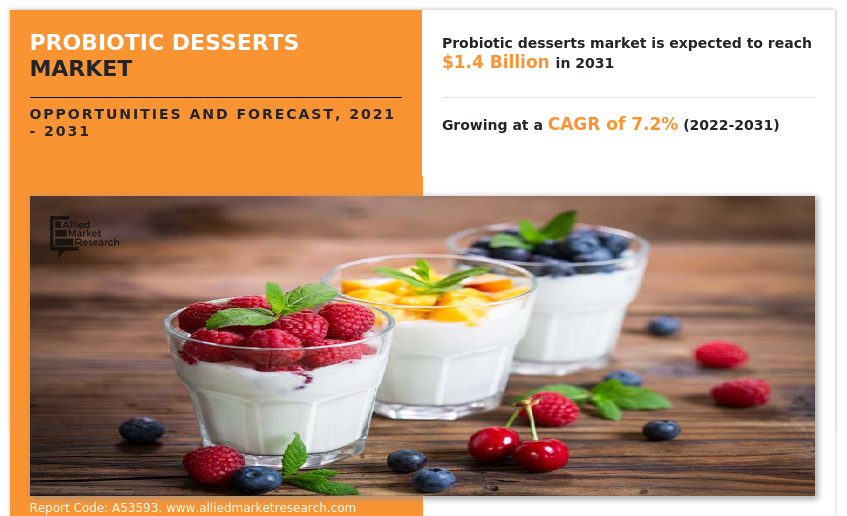
The probiotic desserts industry is segmented into Application, Distribution Channel and Type.
A probiotic dessert market refers to the commercial sector that produces and sells desserts that contain probiotics, which are live microorganisms that are similar to the beneficial bacteria found in the human gut. These desserts are designed to provide consumers with a convenient and tasty way to support digestive health. Some common examples of probiotic desserts include yogurt, kefir, and fermented ice cream.
The probiotic desserts industry trend is characterized by increasing consumer interest in products that support digestive health and wellness. As people become more aware of the importance of gut health, they are looking for convenient and delicious ways to incorporate probiotics into their diets, and probiotic desserts offer a simple solution.
In recent years, there has been a growing demand for probiotic desserts, particularly in developed countries, as consumers seek to add more functional food to their diets. Additionally, the increasing popularity of plant-based diets has led to a rise in demand for vegan probiotic desserts. The probiotic dessert market has seen significant growth in recent years, as consumers seek out healthier and functional food options. Probiotic desserts, such as yogurt and kefir, contain beneficial bacteria that can help improve gut health and boost the immune system. In the past, probiotic products were primarily marketed to adults, but recent trends have shown an increase in demand among children and teenagers.
This may be due to increased awareness of the importance of gut health and its role in overall well-being. Additionally, the spread of plant-based diets and lactose intolerance has increased the popularity of alternative probiotic desserts such as soy-based yogurt and oat milk kefir.
Targeting specific demographics is a key strategy that can help dramatically increase the market demand for probiotic desserts market. By understanding the needs and preferences of specific consumer groups, companies can tailor their products and marketing efforts to meet the needs of that group. For example, the popularity of probiotic desserts among health-conscious consumers is driving demand for products that are low in sugar, high in protein, and contain natural ingredients. Meanwhile, the demand for probiotic desserts for children has led to the development of products that are not only nutritious, but also fun and attractive to children. The company is also targeting seniors who are more likely to suffer from digestive issues and need more probiotics by providing highly digestible and nutritionally balanced food. By targeting specific demographics, businesses can increase market demand for probiotic desserts and reach more customers.
Innovation in taste and ingredients is another factor that has boosted the market demand for probiotic desserts. The company is constantly experimenting with new and unique flavors and ingredients to make probiotic desserts more appealing to consumers. For example, the introduction of exotic fruit flavors such as acai berry and dragon fruit helped attract consumers looking for new and exciting taste experiences. Additionally, by using alternative sweeteners such as stevia and monk fruit, the company has been able to offer low-sugar options that are still delicious and filling. The inclusion of superfood such as chia seeds and matcha in probiotic desserts has also boosted their nutritional profile and appealed to health-conscious consumers. Constant innovation in flavors and ingredients has helped keep market demand for probiotic desserts high and allowed the company to stand out in a crowded market.
Growing interest in functional food is a major factor driving the demand for probiotic desserts in the market. Consumers are increasingly looking for food that offer not only taste and nutritional value, but also additional health benefits. With a reputation for improving gut health and boosting the immune system, probiotics are considered functional food and have skyrocketed in popularity as a result. This has led to an increase in probiotic-rich food, including desserts, in the market. Demand for probiotic desserts continues to grow as consumers look for healthier options to satisfy their sweet cravings. Companies are responding by developing innovative new products and flavors to make probiotic desserts more accessible and appealing to more consumers. Increased availability of probiotic desserts along with growing popularity helps fuel market demand for this product category.
One of the major trends in the probiotic dessert market is a shift towards more natural and organic ingredients. Consumers are increasingly looking for products with simple, recognizable ingredients, as well as products free of artificial preservatives and sweeteners. This trend has also led to the rise of small artisanal probiotic dessert makers offering locally sourced, unique products. Another trend in the probiotic’s dessert market is the introduction of functional ingredients such as prebiotics, probiotics, and functional fibers. In addition to being healthy, these ingredients add a unique texture and flavor to desserts.
The growth of e-commerce has also had a significant impact on the probiotic dessert market. Online shopping platforms, such as Amazon and Instacart, have made it easier for consumers to access a wider variety of probiotic desserts from the comfort of their own homes. Additionally, many probiotic dessert brands now offer subscription services, where customers can receive regular deliveries of their favorite products.
However, the probiotic dessert market is not without its challenges. One major issue is the lack of standardization in the labeling and definition of probiotic products. This has led to confusion among consumers and has resulted in some products being marketed as “probiotic” despite containing only trace amounts of beneficial bacteria. Additionally, some probiotic desserts are expensive compared to their non-probiotic counterparts, which may limit their accessibility to some consumers. The probiotic dessert market has seen significant growth in recent years, driven by consumers seeking healthier and functional food options. With trends towards more natural and organic ingredients, as well as the introduction of functional ingredients, the market is projected to witness continued growth in the coming years. However, challenges such as lack of standardization and high prices may limit the accessibility of probiotic desserts to some consumers.
According to the functional food consumers’ survey conducted by the International Food Information Council, 63% of the consumers in America are aware of functional food and believe that good nutrition is necessary to manage health, thereby increasing the adoption of probiotic desserts market demand.
The National Institutes of Health (NIH) explains that probiotics are live bacteria and yeasts like the microbes found in the human gut and can provide health benefits when consumed in adequate amounts. The World Health Organization (WHO) defines probiotics as “live microorganisms that, when administered in adequate amounts, confer a health benefit on the host”. While probiotic desserts can be a convenient way to consume probiotics, it's important to note that not all probiotic food are created equal, and the health benefits may vary depending on the type and amount of probiotic strains used.
The probiotic desserts market analysis into type, application, distribution channel, and region. According to type, the market is categorized into dairy based and plant based. Depending on application, the probiotic dessert market is fragmented into the yogurt, kefir, ice cream, and others. By distribution channel, it is divided into supermarket and hypermarket, specialty store, e-commerce, and others. Region-wise, the market is analyzed across North America (the U.S., Canada, and Mexico), Europe (Germany, UK, France, Russia, France, Spain, Italy, and the rest of Europe), Asia-Pacific (China, Japan, South Korea, India, Australia, and rest of Asia-Pacific), and LAMEA (Brazil, UAE, Argentina, Saudi Arabia, South Africa, and rest of LAMEA).
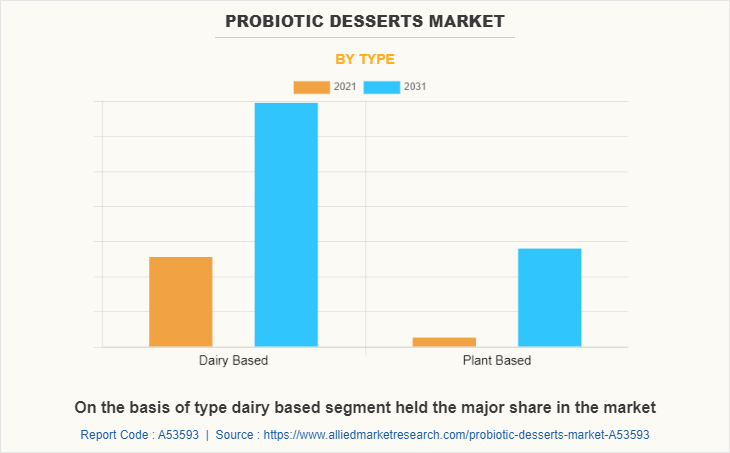
By type, dairy based probiotic desserts held the major share in the market. Growing consumer demand for healthy and functional food is driving the growth of the global market for probiotic dairy desserts. The trend toward healthy, natural food is bolstering the market as consumers look for products that contain natural ingredients and are free of artificial additives. However, the plant-based segment is projected with the highest CAGR from 2022 to 2031. In recent years, various factors such as health concerns, animal welfare, and environmental sustainability have increased the demand for plant-based products including desserts.
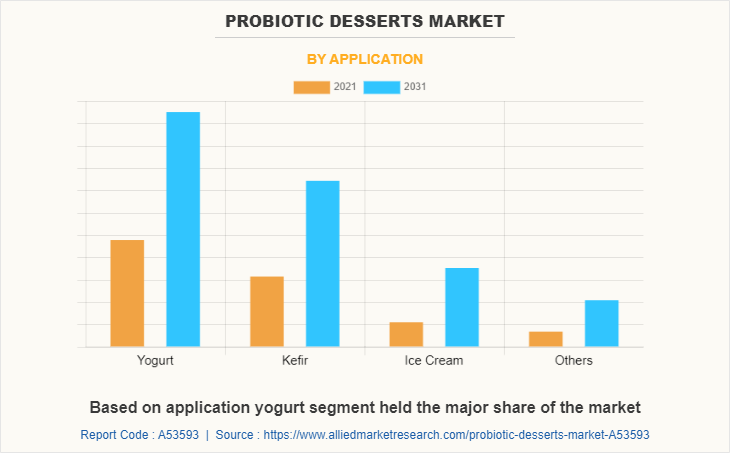
On the basis of application, the yogurt segment held a major share in the probiotic desserts market growth and is expected to dominate during the forecast period. The probiotic yogurt industry is expanding as a result of consumers' increased interest in natural and organic products. Many customers go for probiotic yoghurt products that use organic ingredients and less processing because they consider it as a natural way to boost health. However, the ice cream segment is projected to manifest the highest CAGR from 2022 to 2031 probiotic desserts market forecast period.
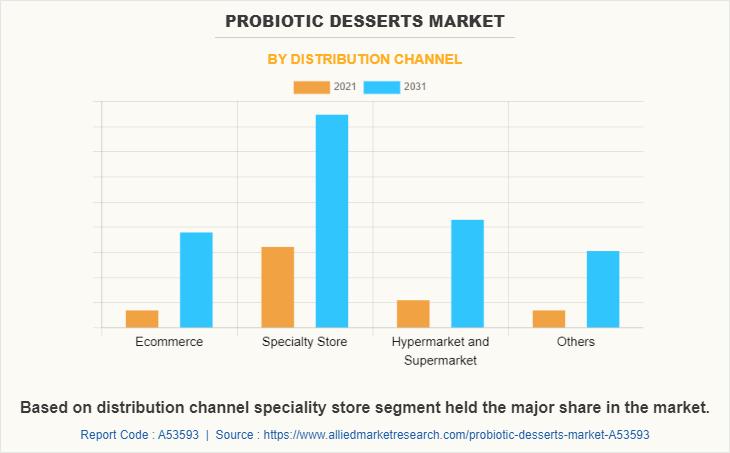
Based on the distribution channel, the specialty store segment held the major share in the probiotic desserts market Specialty stores provide high-quality service and detailed product specifications & expert guidance to customers. The continuously evolving retail industry along with changes in consumer behavior and improvement in overall lifestyle across the world have led to the introduction of specialized retail formats. However, the e-commerce segment is projected to manifest the highest CAGR from 2022 to 2031. E-commerce serves as a popular medium for the purchase of nutraceuticals. Large-scale internet penetration and the availability of a myriad of sites for shopping online are some of the major reasons for the growth of online shopping.
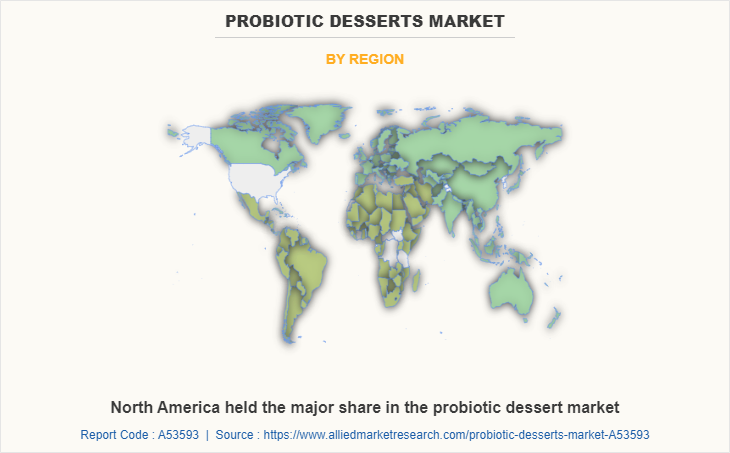
North America held the major share in the probiotic desserts market. Digestive problems among the adult population in the U.S. due to poor food consumption habits, intake of huge number of antibiotics, and use of additives for food processing have augmented the demand for probiotics. However, the Asia-Pacific region is projected to manifest the highest CAGR from 2022 to 2031. In terms of market growth, the Asia-Pacific probiotic desserts market is expected to continue to grow rapidly in the coming years, Growth in awareness about probiotics in China and India has led to increased demand for probiotics desserts.
The major players operating in the global probiotic desserts market share are Lancashire Farm, Sovos Brands, Inc., General Mills, Inc., Chobani Global Holdings, LLC, Danone Inc., Fonterra Co-operative Group Limited, Meiji Holdings Co., Ltd., National Dairy Development Board, Yofix, and Forager Project.
Key Benefits For Stakeholders
- This report provides a quantitative analysis of the market segments, current trends, estimations, and dynamics of the probiotic desserts market size analysis from 2021 to 2031 to identify the prevailing probiotic desserts market opportunities.
- The market research is offered along with information related to key drivers, restraints, and opportunities.
- Porter's five forces analysis highlights the potency of buyers and suppliers to enable stakeholders make profit-oriented business decisions and strengthen their supplier-buyer network.
- In-depth analysis of the probiotic desserts market segmentation assists to determine the prevailing market opportunities.
- Major countries in each region are mapped according to their revenue contribution to the global market.
- Market player positioning facilitates benchmarking and provides a clear understanding of the present position of the market players.
- The report includes the analysis of the regional as well as global probiotic desserts market trends, key players, market segments, application areas, and market growth strategies.
Probiotic Desserts Market Report Highlights
| Aspects | Details |
| Market Size By 2031 | USD 1.4 billion |
| Growth Rate | CAGR of 7.2% |
| Forecast period | 2021 - 2031 |
| Report Pages | 247 |
| By Application |
|
| By Distribution Channel |
|
| By Type |
|
| By Region |
|
| Key Market Players | General Mills, Inc., Forager Project, Danone Inc., Chobani Global Holdings, LLC, Sovos Brands, Inc., Meiji Holdings Co., Ltd., Fonterra Co-operative Group Limited, National Dairy Development Board., Yofix, Lancashire Farm |
Analyst Review
Probiotic dessert is witnessing an increasing demand across the world; especially, the demand from pharmaceutical and food & beverage industries are driving the market growth. Probiotics is the emerging market owing to its numerous associated benefits such as warding off infection, boosting immune systems, and helping treat irritable bowel syndrome, infectious diarrhea, and some skin diseases. It is the perfect alternative for conventional antibiotics, since it helps to maintain the balance of good bacteria in the human and animal gut.
Numerous companies are operating in this market and are continuously developing advanced technology for processing and storing probiotics to support the growing demand for probiotic derived items in the market. With a wide scale adoption of probiotics in food products & dietary supplements along with rapid technological advancements, the world probiotics market is anticipated to grow steadily. Companies are investing heavily in research and development to provide the customers with optimum solutions
Rise in consumption of functional food are the upcoming trends of Probiotic Desserts Market.
Yogurt is the leading application of Probiotic Desserts Market.
North America is the largest regional market for Probiotic Desserts.
The global probiotic desserts market was valued at $680.7 million in 2021, and is projected to reach $1,375.1 million by 2031, registering a CAGR of 7.2%.
The major players operating in the global probiotic desserts market are Lancashire Farm, Sovos Brands, Inc., General Mills, Inc., Chobani Global Holdings, LLC, Danone Inc., Fonterra Co-operative Group Limited, Meiji Holdings Co., Ltd., National Dairy Development Board, Yofix, and Forager Project.
Loading Table Of Content...



